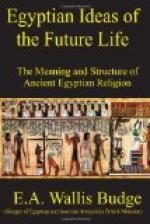Whenever and wherever the Egyptians attempted to set up a system of gods they always found that the old local gods had to be taken into consideration, and a place had to be found for them in the system. This might be done by making them members of triads, or of groups of nine gods, now commonly called “enneads”; but in one form or other they had to appear. The researches made during the last few years have shown that there must have been several large schools of theological thought in Egypt, and of each of these the priests did their utmost to proclaim the superiority of their gods. In dynastic times there must have been great colleges at Heliopolis, Memphis, Abydos, and one or more places in the Delta, not to mention the smaller schools of priests which, probably existed at places on both sides of the Nile from Memphis to the south. Of the theories and doctrines of all such schools and colleges, those of Heliopolis have survived in the completest form, and by careful examination of the funeral texts which were inscribed on the monuments of the kings of Egypt of the Vth and VIth dynasties we can say what views they held about many of the gods. At the outset we see that the great god of Heliopolis was Temu or Atmu, the setting sun, and to him the priests of that place ascribed the attributes which rightly belong to R[=a], the Sun-god of the day-time. For some reason or other they formulated the idea of a company of the gods, nine in number, which was called the “great company (paut) of the gods,” and at the head of this company they placed the god Temu. In Chapter XVII of the Book of the Dead [Footnote: See Chapters of Coming Forth by Day, p. 49.] we find the following passage:—
“I am the god Temu in his rising;
I am the only One. I came into being
in Nu. I am R[=a] who rose in the
beginning.”
Next comes the question, “But who is this?” And the answer is: “It is R[=a] when at the beginning he rose in the city of Suten-henen (Heracleopolis Magna) crowned like a king in rising. The pillars of the god Shu were not as yet created when he was upon the staircase of him that dwelleth in Khemennu (Hermopolis Magna).” From these statements we learn that Temu and R[=a] were one and the same god, and that he was the first offspring of the god Nu, the primeval watery mass out of which all the gods came into being. The text continues: “I am the great god Nu who gave birth to himself, and who made his names to come into being and to form the company of the gods. But who is this?




